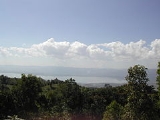
Inle Lake
Encyclopedia
Inle Lake is a freshwater
lake
located in the Nyaungshwe Township
of Taunggyi District
of Shan State
, part of Shan Hills
in Myanmar
(Burma). It is the second largest lake in Myanmar with an estimated surface area of 44.9 square miles (116.3 km²), and one of the highest at an altitude of 2900 feet (883.9 m). During the dry season, the average water depth is 7 feet (2.1 m), with the deepest point being 12 feet (3.7 m), but during the rainy season
this can increase by 5 feet (1.5 m).
The watershed area for the lake lies to a large extent to the north and west of the lake. The lake drains through the Nam Pilu or Balu Chaung on its southern end. There is a hot spring on its northwestern shore.
Although not a large lake, there are a number of endemic species. Over twenty species of snails and nine species of fish are found nowhere else in the world. Some of these, like the silver-blue scaleless Sawbwa barb (Sawbwa resplendens), the Crossbanded dwarf danio (Microrasbora erythromicron), and Inle danio (Inlecypris auropurpurea), are of minor commercial importance for the aquarium trade. It hosts the 20,000 brown and black head migratory seagulls in November, December and January.
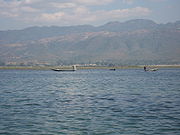
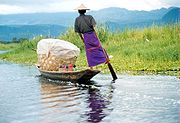
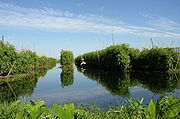 The people of Inle Lake (called Intha), some 70,000 of them, live in four cities bordering the lake, in numerous small villages along the lake's shores, and on the lake itself. The entire lake area is in Nyaung Shwe
The people of Inle Lake (called Intha), some 70,000 of them, live in four cities bordering the lake, in numerous small villages along the lake's shores, and on the lake itself. The entire lake area is in Nyaung Shwe
township. The population consists predominantly of Intha
, with a mix of other Shan, Taungyo, Pa-O
(Taungthu), Danu
, Kayah, Danaw and Bamar
ethnicities. Most are devout Buddhists, and live in simple houses of wood and woven bamboo
on stilts; they are largely self-sufficient farmers.
Most transportation on the lake is traditionally by small boats, or by somewhat larger boats fitted with outboard motors. Local fishermen are known for practicing a distinctive rowing style which involves standing at the stern on one leg and wrapping the other leg around the oar. This unique style evolved for the reason that the lake is covered by reeds and floating plants making it difficult to see above them while sitting. Standing provides the rower with a view beyond the reeds. However, the leg rowing style is only practiced by the men. Women row in the customary style, using the oar with their hands, sitting cross legged at the stern.
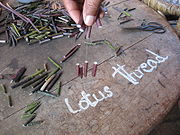
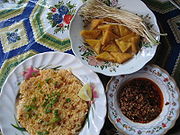 Fish caught from the lake - the most abundant kind is called nga hpein (Inle Carp, Cyprinus intha) - are a staple of the local diet. A popular local dish is htamin gyin - 'fermented' rice kneaded with fish and/or potato - served with hnapyan gyaw (literally twice fried - Shan tofu
Fish caught from the lake - the most abundant kind is called nga hpein (Inle Carp, Cyprinus intha) - are a staple of the local diet. A popular local dish is htamin gyin - 'fermented' rice kneaded with fish and/or potato - served with hnapyan gyaw (literally twice fried - Shan tofu
). In addition to fish
ing, locals grow vegetable
s and fruit
in large gardens that float on the surface of the lake. The floating garden beds are formed by extensive manual labor. The farmers gather up lake-bottom weeds from the deeper parts of the lake, bring them back in boats and make them into floating beds in their garden areas, anchored by bamboo poles. These gardens rise and fall with changes in the water level, and so are resistant to flooding. The constant availability of nutrient-laden water results in these gardens being incredibly fertile. Rice cultivation is also significant.
Hand-made goods for local use and trading are another source of commerce. Typical products include tools, carvings and other ornamental objects, textiles, and cheroot
s. A local market serves most common shopping needs and is held daily but the location of the event rotates through five different sites around the lake area, thus each of them hosting an itinerant market every fifth day. When held on the lake itself, trading is conducted from small boats. This 'floating-market' event tends to emphasize tourist trade much more than the other four.
The Inle lake area is renowned for its weaving industry. The Shan-bags, used daily by many Burmese as a tote-bag, are produced in large quantities here. Silk-weaving is another very important industry, producing high-quality hand-woven silk fabrics of distinctive design called Inle longyi
. A unique fabric from the lotus plant fibers is produced only at Inle lake and is used for weaving special robes for Buddha
images called kya thingahn (lotus robe).
Lumber
removal and unsustainable cultivation practices (slash and burn
farming techniques) on the hills surrounding the lake are causing ever-increasing amounts of silt
and nutrients to run off into the rivers that feed the lake, especially along its western and northern watershed areas. This silt fills up the lake; the nutrients encourage the growth of weeds and algae
. More important however is the development of floating garden agriculture, largely along the western side of the lake. This practice encroaches into the diminishing area of the lake, since over time, the floating beds become solid ground. About 93% (nearly 21 km²) of the recent loss in open water area of the lake, largely along its western side, is thought to be due to this agricultural practice. Direct environmental impacts associated with these combined agricultural activities within the wetland
s and surrounding hills of the lake include sedimentation
, eutrophication
, and pollution
.
The water hyacinth
, a plant not native to the lake, also poses a major problem. It grows rapidly, filling up the smaller streams and large expanses of the lake, robbing native plants and animals of nutrients and sunlight. At one time, all boats coming into Nyaung Shwe were required to bring in a specified amount of water hyacinth. Over the past twenty years, large-scale use of dredges and pumps has been employed with some success in controlling the growth of this plant. On a smaller scale, public awareness education and small-scale control have also been successful.
Another cause for concern is the planned introduction of non-native fish species, such as the Grass Carp
(Ctenopharyngodon idella)] intended to improve fishery.
Sanitation in the villages around the lake is an ongoing concern for public health authorities, due to untreated sewage
and waste water flowing into the lake. To ensure fresh and clean water, some villages now have enclosed wells and public access to the well water.
Noise pollution is also a noticeable issue. The noise from the cheaper unmuffled diesel engines driving the outboard motors is significant, and can be a distraction to the otherwise tranquil lake.
The summer of 2010 registered very high temperatures causing the water level of the lake to drop so low, the lowest in nearly 50 years, that drinking water had to be fetched from elsewhere and the floating market was in danger of disappearing. One other serious consequence was that the hydroelectric
plant at Lawpita, where the former capital Yangon
received its power supply from, could not operate at its full capacity.
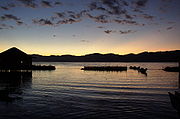 The best time of the year to visit is during September and October. The ceremonial Hpaung Daw U Festival
The best time of the year to visit is during September and October. The ceremonial Hpaung Daw U Festival
, which lasts for almost three weeks, is closely followed by the Thadingyut festival of lights. Inthas and Shan turn out in their best clothes in great numbers to celebrate the Buddhist Lent
. Traditional boat racing, with dozens of leg-rowers in Shan dress in a team on each boat, is a famous event during the Hpaung Daw U Festival
.
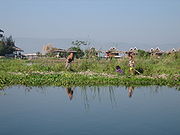 Inle Lake is a major tourist attraction, and this has led to some development of tourist infrastructure. Many small and large privately owned hotels and tour operations have arisen during the past few years. Local shops are flooded with consumer items, both local and foreign. The nearest airport is Heho which is 35 km away. There are flights from both Yangon
Inle Lake is a major tourist attraction, and this has led to some development of tourist infrastructure. Many small and large privately owned hotels and tour operations have arisen during the past few years. Local shops are flooded with consumer items, both local and foreign. The nearest airport is Heho which is 35 km away. There are flights from both Yangon
and Mandalay
. Yangon is 660 km distant by road, Mandalay 330 km.
Inle Lake is in the heart of Shan State, which has been the location of much of the civil and political strife over the last two decades. Political imprisonments and disappearances are common.
-
a rice, tomato and potato or fish salad kneaded into round balls dressed and garnished with crisp fried onion in oil, tamarind sauce, coriander and spring onions often with garlic, Chinese chives roots (ju myit), fried whole dried chili, grilled dried fermented beancakes (pè bouk} and fried dried topu (topu jauk kyaw) on the side.
Freshwater
Fresh water is naturally occurring water on the Earth's surface in ice sheets, ice caps, glaciers, bogs, ponds, lakes, rivers and streams, and underground as groundwater in aquifers and underground streams. Fresh water is generally characterized by having low concentrations of dissolved salts and...
lake
Lake
A lake is a body of relatively still fresh or salt water of considerable size, localized in a basin, that is surrounded by land. Lakes are inland and not part of the ocean and therefore are distinct from lagoons, and are larger and deeper than ponds. Lakes can be contrasted with rivers or streams,...
located in the Nyaungshwe Township
Nyaungshwe Township
Nyaungshwe Township is a township of Taunggyi District in the Shan State of Myanmar. The principal town is Nyaungshwe.Inle Lake, a popular tourist site and a inland fresh water lake, is in the south of Nyaungshwe Town....
of Taunggyi District
Taunggyi District
Taunggyi District is a district of Shan State in Burma. The principal town and administrative center is Taunggyi. This district has 12 towns and 3001 villages.-Townships:The district contains the following townships:*Taunggyi Township*Nyaungshwe Township...
of Shan State
Shan State
Shan State is a state of Burma . Shan State borders China to the north, Laos to the east, and Thailand to the south, and five administrative divisions of Burma in the west. Largest of the 14 administrative divisions by land area, Shan State covers 155,800 km², almost a quarter of the total...
, part of Shan Hills
Shan Hills
The Shan Hills , also known as Shan Highland, are part of the range of hills that extends through Yunnan to Burma and Thailand, linking to the Himalayas, of which they may be considered foothills.-Etymology:...
in Myanmar
Myanmar
Burma , officially the Republic of the Union of Myanmar , is a country in Southeast Asia. Burma is bordered by China on the northeast, Laos on the east, Thailand on the southeast, Bangladesh on the west, India on the northwest, the Bay of Bengal to the southwest, and the Andaman Sea on the south....
(Burma). It is the second largest lake in Myanmar with an estimated surface area of 44.9 square miles (116.3 km²), and one of the highest at an altitude of 2900 feet (883.9 m). During the dry season, the average water depth is 7 feet (2.1 m), with the deepest point being 12 feet (3.7 m), but during the rainy season
Monsoon
Monsoon is traditionally defined as a seasonal reversing wind accompanied by corresponding changes in precipitation, but is now used to describe seasonal changes in atmospheric circulation and precipitation associated with the asymmetric heating of land and sea...
this can increase by 5 feet (1.5 m).
The watershed area for the lake lies to a large extent to the north and west of the lake. The lake drains through the Nam Pilu or Balu Chaung on its southern end. There is a hot spring on its northwestern shore.
Although not a large lake, there are a number of endemic species. Over twenty species of snails and nine species of fish are found nowhere else in the world. Some of these, like the silver-blue scaleless Sawbwa barb (Sawbwa resplendens), the Crossbanded dwarf danio (Microrasbora erythromicron), and Inle danio (Inlecypris auropurpurea), are of minor commercial importance for the aquarium trade. It hosts the 20,000 brown and black head migratory seagulls in November, December and January.
People and culture



Nyaung Shwe
Nyaung Shwe is a town a few kilometers north of Inle Lake in the Shan State of Myanmar.It is located south of Sakangyi and southwest of Taunggyi. Bawrithat Pagoda lies in the southern part of the town....
township. The population consists predominantly of Intha
Intha people
The Intha are members of a Tibeto-Burman ethnic group living around Inle Lake. They speak an archaic dialect of Burmese, and are believed to have come from the Dawei area. They often live on Inle Lake, and support themselves through the tending of vegetable farms on floating gardens...
, with a mix of other Shan, Taungyo, Pa-O
Pa-O
The Pa-Oh form an ethnic group in Burma, comprising approximately 600,000. The Pa-Oh form the second largest ethnic group in Shan State, and are classified as part of the "Shan National Race" by the government, although they are believed to be of Tibeto-Burman stock, and are ethnolinguistically...
(Taungthu), Danu
Danu people
The Danu people are a sub-ethnic group of the Bamar, predominantly populating the areas near Pindaya Caves, in Shan State of Burma. They speak an archaic dialect of Burmese.-External links:*...
, Kayah, Danaw and Bamar
Bamar
The Bamar are the dominant ethnic group of Burma , constituting approximately two-thirds of the population. The Bamar live primarily in the Irrawaddy basin, and speak the Burmese language, which is also the official language of Burma. Bamar customs and identity are closely intertwined with general...
ethnicities. Most are devout Buddhists, and live in simple houses of wood and woven bamboo
Bamboo
Bamboo is a group of perennial evergreens in the true grass family Poaceae, subfamily Bambusoideae, tribe Bambuseae. Giant bamboos are the largest members of the grass family....
on stilts; they are largely self-sufficient farmers.
Most transportation on the lake is traditionally by small boats, or by somewhat larger boats fitted with outboard motors. Local fishermen are known for practicing a distinctive rowing style which involves standing at the stern on one leg and wrapping the other leg around the oar. This unique style evolved for the reason that the lake is covered by reeds and floating plants making it difficult to see above them while sitting. Standing provides the rower with a view beyond the reeds. However, the leg rowing style is only practiced by the men. Women row in the customary style, using the oar with their hands, sitting cross legged at the stern.


Burmese tofu
Burmese tofu is a food of Shan origin and is different from Chinese tofu in that it is not made from soy milk and not set with a coagulant. Shan tofu is produced in a similar fashion to polenta, with its primary ingredient being water and flour ground from yellow split peas and the Burmese version...
). In addition to fish
Fish
Fish are a paraphyletic group of organisms that consist of all gill-bearing aquatic vertebrate animals that lack limbs with digits. Included in this definition are the living hagfish, lampreys, and cartilaginous and bony fish, as well as various extinct related groups...
ing, locals grow vegetable
Vegetable
The noun vegetable usually means an edible plant or part of a plant other than a sweet fruit or seed. This typically means the leaf, stem, or root of a plant....
s and fruit
Fruit
In broad terms, a fruit is a structure of a plant that contains its seeds.The term has different meanings dependent on context. In non-technical usage, such as food preparation, fruit normally means the fleshy seed-associated structures of certain plants that are sweet and edible in the raw state,...
in large gardens that float on the surface of the lake. The floating garden beds are formed by extensive manual labor. The farmers gather up lake-bottom weeds from the deeper parts of the lake, bring them back in boats and make them into floating beds in their garden areas, anchored by bamboo poles. These gardens rise and fall with changes in the water level, and so are resistant to flooding. The constant availability of nutrient-laden water results in these gardens being incredibly fertile. Rice cultivation is also significant.
Hand-made goods for local use and trading are another source of commerce. Typical products include tools, carvings and other ornamental objects, textiles, and cheroot
Cheroot
The cheroot or stogie is a cylindrical cigar with both ends clipped during manufacture. Since cheroots do not taper, they are inexpensive to roll mechanically, and their low cost makes them particularly popular. Typically, stogies have a length of 3.5 to 6.5 inches, and a ring gauge of 34 to...
s. A local market serves most common shopping needs and is held daily but the location of the event rotates through five different sites around the lake area, thus each of them hosting an itinerant market every fifth day. When held on the lake itself, trading is conducted from small boats. This 'floating-market' event tends to emphasize tourist trade much more than the other four.
The Inle lake area is renowned for its weaving industry. The Shan-bags, used daily by many Burmese as a tote-bag, are produced in large quantities here. Silk-weaving is another very important industry, producing high-quality hand-woven silk fabrics of distinctive design called Inle longyi
Longyi
A longyi is a sheet of cloth widely worn in Burma. It is approximately 2 m long and 80 cm wide. The cloth is often sewn into a cylindrical shape. It is worn around the waist, running to the feet. It is held in place by folding fabric over, without a knot. It is also sometimes folded up to...
. A unique fabric from the lotus plant fibers is produced only at Inle lake and is used for weaving special robes for Buddha
Gautama Buddha
Siddhārtha Gautama was a spiritual teacher from the Indian subcontinent, on whose teachings Buddhism was founded. In most Buddhist traditions, he is regarded as the Supreme Buddha Siddhārtha Gautama (Sanskrit: सिद्धार्थ गौतम; Pali: Siddhattha Gotama) was a spiritual teacher from the Indian...
images called kya thingahn (lotus robe).
Environmental concerns
Inle Lake is suffering from the environmental effects of increased population and rapid growth in both agriculture and tourism. During the 65-year period from 1935 to 2000, the net open water area of Inle Lake decreased from 69.10 km² to 46.69 km², a loss of 32.4%.Lumber
Lumber
Lumber or timber is wood in any of its stages from felling through readiness for use as structural material for construction, or wood pulp for paper production....
removal and unsustainable cultivation practices (slash and burn
Slash and burn
Slash-and-burn is an agricultural technique which involves cutting and burning of forests or woodlands to create fields. It is subsistence agriculture that typically uses little technology or other tools. It is typically part of shifting cultivation agriculture, and of transhumance livestock...
farming techniques) on the hills surrounding the lake are causing ever-increasing amounts of silt
Silt
Silt is granular material of a size somewhere between sand and clay whose mineral origin is quartz and feldspar. Silt may occur as a soil or as suspended sediment in a surface water body...
and nutrients to run off into the rivers that feed the lake, especially along its western and northern watershed areas. This silt fills up the lake; the nutrients encourage the growth of weeds and algae
Algae
Algae are a large and diverse group of simple, typically autotrophic organisms, ranging from unicellular to multicellular forms, such as the giant kelps that grow to 65 meters in length. They are photosynthetic like plants, and "simple" because their tissues are not organized into the many...
. More important however is the development of floating garden agriculture, largely along the western side of the lake. This practice encroaches into the diminishing area of the lake, since over time, the floating beds become solid ground. About 93% (nearly 21 km²) of the recent loss in open water area of the lake, largely along its western side, is thought to be due to this agricultural practice. Direct environmental impacts associated with these combined agricultural activities within the wetland
Wetland
A wetland is an area of land whose soil is saturated with water either permanently or seasonally. Wetlands are categorised by their characteristic vegetation, which is adapted to these unique soil conditions....
s and surrounding hills of the lake include sedimentation
Sedimentation
Sedimentation is the tendency for particles in suspension to settle out of the fluid in which they are entrained, and come to rest against a barrier. This is due to their motion through the fluid in response to the forces acting on them: these forces can be due to gravity, centrifugal acceleration...
, eutrophication
Eutrophication
Eutrophication or more precisely hypertrophication, is the movement of a body of water′s trophic status in the direction of increasing plant biomass, by the addition of artificial or natural substances, such as nitrates and phosphates, through fertilizers or sewage, to an aquatic system...
, and pollution
Pollution
Pollution is the introduction of contaminants into a natural environment that causes instability, disorder, harm or discomfort to the ecosystem i.e. physical systems or living organisms. Pollution can take the form of chemical substances or energy, such as noise, heat or light...
.
The water hyacinth
Water hyacinth
The seven species of water hyacinth comprise the genus Eichhornia. Water hyacinth are a free-floating perennial aquatic plant native to tropical and sub-tropical South America. With broad, thick, glossy, ovate leaves, water hyacinth may rise above the surface of the water as much as 1 meter in...
, a plant not native to the lake, also poses a major problem. It grows rapidly, filling up the smaller streams and large expanses of the lake, robbing native plants and animals of nutrients and sunlight. At one time, all boats coming into Nyaung Shwe were required to bring in a specified amount of water hyacinth. Over the past twenty years, large-scale use of dredges and pumps has been employed with some success in controlling the growth of this plant. On a smaller scale, public awareness education and small-scale control have also been successful.
Another cause for concern is the planned introduction of non-native fish species, such as the Grass Carp
Grass carp
The grass carp is a herbivorous, freshwater fish species of family Cyprinidae, and the only species of the genus Ctenopharyngodon. It is cultivated in China for food, but was introduced in Europe and the United States for aquatic weed control...
(Ctenopharyngodon idella)] intended to improve fishery.
Sanitation in the villages around the lake is an ongoing concern for public health authorities, due to untreated sewage
Sewage
Sewage is water-carried waste, in solution or suspension, that is intended to be removed from a community. Also known as wastewater, it is more than 99% water and is characterized by volume or rate of flow, physical condition, chemical constituents and the bacteriological organisms that it contains...
and waste water flowing into the lake. To ensure fresh and clean water, some villages now have enclosed wells and public access to the well water.
Noise pollution is also a noticeable issue. The noise from the cheaper unmuffled diesel engines driving the outboard motors is significant, and can be a distraction to the otherwise tranquil lake.
The summer of 2010 registered very high temperatures causing the water level of the lake to drop so low, the lowest in nearly 50 years, that drinking water had to be fetched from elsewhere and the floating market was in danger of disappearing. One other serious consequence was that the hydroelectric
Hydroelectricity
Hydroelectricity is the term referring to electricity generated by hydropower; the production of electrical power through the use of the gravitational force of falling or flowing water. It is the most widely used form of renewable energy...
plant at Lawpita, where the former capital Yangon
Yangon
Yangon is a former capital of Burma and the capital of Yangon Region . Although the military government has officially relocated the capital to Naypyidaw since March 2006, Yangon, with a population of over four million, continues to be the country's largest city and the most important commercial...
received its power supply from, could not operate at its full capacity.
Tourism

Hpaung Daw U Pagoda
Hpaung Daw U Pagoda , ; also spelt Hpaung Daw Oo or Phaung Daw Oo) is a notable Buddhist site in Burma , located on Inle Lake in Shan State....
, which lasts for almost three weeks, is closely followed by the Thadingyut festival of lights. Inthas and Shan turn out in their best clothes in great numbers to celebrate the Buddhist Lent
Lent
In the Christian tradition, Lent is the period of the liturgical year from Ash Wednesday to Easter. The traditional purpose of Lent is the preparation of the believer – through prayer, repentance, almsgiving and self-denial – for the annual commemoration during Holy Week of the Death and...
. Traditional boat racing, with dozens of leg-rowers in Shan dress in a team on each boat, is a famous event during the Hpaung Daw U Festival
Hpaung Daw U Pagoda
Hpaung Daw U Pagoda , ; also spelt Hpaung Daw Oo or Phaung Daw Oo) is a notable Buddhist site in Burma , located on Inle Lake in Shan State....
.

Yangon
Yangon is a former capital of Burma and the capital of Yangon Region . Although the military government has officially relocated the capital to Naypyidaw since March 2006, Yangon, with a population of over four million, continues to be the country's largest city and the most important commercial...
and Mandalay
Mandalay
Mandalay is the second-largest city and the last royal capital of Burma. Located north of Yangon on the east bank of the Irrawaddy River, the city has a population of one million, and is the capital of Mandalay Region ....
. Yangon is 660 km distant by road, Mandalay 330 km.
Inle Lake is in the heart of Shan State, which has been the location of much of the civil and political strife over the last two decades. Political imprisonments and disappearances are common.
Cuisine
Inle cuisine is different from Shan cuisine, as it incorporates local natural produce. The most well-known Inle dish would be the Htamin jinHtamin jin
Htamin Jin, is a Burmese dish of fermented rice. It is the regional specialty and signature dish of the Intha people of Inle Lake in Shan State, Myanmar....
-
a rice, tomato and potato or fish salad kneaded into round balls dressed and garnished with crisp fried onion in oil, tamarind sauce, coriander and spring onions often with garlic, Chinese chives roots (ju myit), fried whole dried chili, grilled dried fermented beancakes (pè bouk} and fried dried topu (topu jauk kyaw) on the side.
External links
- images from Inle Lake
- The Cotton Weaving Industry of Inle inc. video
- Where Even Dead Flowers are Doomed Kyi Wai, The IrrawaddyThe IrrawaddyThis article is about a newsmagazine. For other uses of the term, please see Irrawaddy.For the Second World War battle honour, see Battle of Pokoku and Irrawaddy River operations...
, September 1, 2007 - Poisoned Waters Kyi Wai, The IrrawaddyThe IrrawaddyThis article is about a newsmagazine. For other uses of the term, please see Irrawaddy.For the Second World War battle honour, see Battle of Pokoku and Irrawaddy River operations...
, September 1, 2007 - Large scale manufacture of Shan tofu at Inle Lake video
- Inle Lake Photo Gallery

